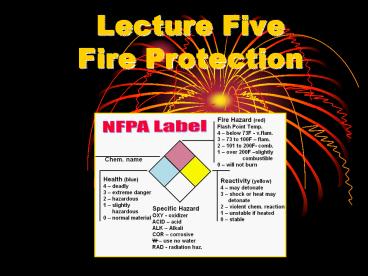Lecture Five Fire Protection - PowerPoint PPT Presentation
1 / 17
Title:
Lecture Five Fire Protection
Description:
Lecture Five Fire Protection Causes of Fires Fire Hazards Defined Conditions that favor the development or growth of fire. Mishandling fuel and heat is most common cause. – PowerPoint PPT presentation
Number of Views:48
Avg rating:3.0/5.0
Title: Lecture Five Fire Protection
1
Lecture FiveFire Protection
2
Causes of Fires
Fuel
Fire
Heat
Oxygen
Fire Triad
3
Fire Hazards Defined
- Conditions that favor the development or growth
of fire. - Mishandling fuel and heat is most common cause.
4
Fire Hazards Defined
- Spontaneous Combustion
- Flashpoint
5
Four Classes of Fires
- A type fires involve ordinary combustibles such
as wood, paper, cloth, and many plastics.
A
6
Four Classes of Fires
B
- B type fires involve flamable or combustible
liquids, greases, and gases.
7
Four Classes of Fires
- C type fires involve energized electrical
equipment.
C
8
Four Classes of Fires
- D type fires involve combustible metals such as
magnesium, titanium, zirconium, sodium, ans
potassium.
D
9
Fires and Explosion Hazards
- Gasoline Flashpoint is -45 degrees Fahrenheit.
Kerosene Flashpoint is 100 degrees Fahrenheit.
Carbon monoxide Orderless and tasteless, and
poisonous, is the product of incomplete
combustion. In concentrations greater than 12
it will ignite when it contacts open flame.
10
Preventing Fires and Explosions
- Practice Good Housekeeping
11
Preventing Fires and Explosions
- Isolating the Fuel
12
Preventing Fires and Explosions
- Controlling Electrical Hazards
13
Fire Fighting Substances
- Water Reduces temperature.
- Sand Suffocates.
- Salt Acts like sand.
14
Fire Hoses
- Must handled carefully.
- Must be drained after use.
- Should be unfolded and refolded 3 or 4 times each
year. - Should be tested 1 time each year to 150 PSI.
15
Portable Fire Extinguishers
- Type A (water units) For normal combustibles
only. - Type A,B (AFFF) For type A and B fires.
- Type B,C (Co2) For use on B and C fires.
Suffocation hazard. - Type ABC (Halon)
- Dry Chemical (monoammonium phosphate)
16
Portable Fire Extinguishers
- Stored Pressure vs. Cartridge Units
- Dry Powders (Class D Fires)
- Sand, Graphite, Sodium Chloride, Talc, and Soda
Ash.
17
Protecting Yourself
- 1. Practice good house keeping.
- 2. Dont let the 4 conditions of the Fire Triad
come together at the same time. - 3. Learn how and when to use fire fighting
equipment. - 4. Never fight a fire you cant handle.






























